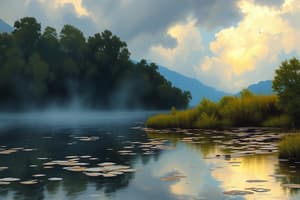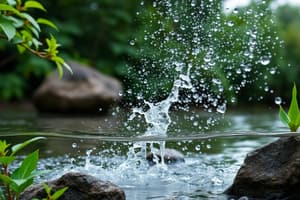Podcast
Questions and Answers
What is the driving force behind the water cycle?
What is the driving force behind the water cycle?
- Human activities
- Ocean currents
- Energy from the sun (correct)
- Wind movement
What happens during the process of condensation in the water cycle?
What happens during the process of condensation in the water cycle?
- Droplets evaporate back into water vapour
- Cool temperatures cause water vapour to turn into droplets (correct)
- Water vapour forms due to intense heat
- Water droplets combine with ground water
What initiates the process of evaporation in the water cycle?
What initiates the process of evaporation in the water cycle?
- Movement of aquatic organisms
- Low atmospheric pressure
- Sunlight warming the water surface (correct)
- Changes in humidity levels
How do water droplets form clouds during condensation?
How do water droplets form clouds during condensation?
What is the term used to describe the continuous movement of water between land, sky, and sea?
What is the term used to describe the continuous movement of water between land, sky, and sea?
What is the primary process by which water droplets fall from clouds as rain?
What is the primary process by which water droplets fall from clouds as rain?
How does the altitude of clouds affect the form of precipitation?
How does the altitude of clouds affect the form of precipitation?
What role does wind play in the water cycle?
What role does wind play in the water cycle?
What happens to precipitation as the distance from the ocean increases?
What happens to precipitation as the distance from the ocean increases?
What is the source of most precipitation?
What is the source of most precipitation?
Which statement best describes the water cycle?
Which statement best describes the water cycle?
What fraction of precipitation falls as rain, according to the content?
What fraction of precipitation falls as rain, according to the content?
Where do the largest water droplets in precipitation typically originate?
Where do the largest water droplets in precipitation typically originate?
What is the primary source of water on Earth?
What is the primary source of water on Earth?
How does precipitation form in the water cycle?
How does precipitation form in the water cycle?
What percentage of the Earth's surface is covered by the ocean?
What percentage of the Earth's surface is covered by the ocean?
What percentage of Earth's total water is contained in the oceans?
What percentage of Earth's total water is contained in the oceans?
Which part of the water cycle directly follows precipitation?
Which part of the water cycle directly follows precipitation?
In which process does water change from liquid to vapor?
In which process does water change from liquid to vapor?
What happens to water vapour in the clouds during the water cycle?
What happens to water vapour in the clouds during the water cycle?
Which of the following is an important step in the water cycle?
Which of the following is an important step in the water cycle?
What is the result of condensation in the water cycle?
What is the result of condensation in the water cycle?
Why is the ocean significant in discussing the water cycle?
Why is the ocean significant in discussing the water cycle?
What is the main reason unfolded wet clothes dry more quickly than folded ones?
What is the main reason unfolded wet clothes dry more quickly than folded ones?
Which of the following statements about the water cycle is true?
Which of the following statements about the water cycle is true?
Which of the following processes is NOT part of the water cycle?
Which of the following processes is NOT part of the water cycle?
What composition is found in clouds?
What composition is found in clouds?
What effect does a larger surface area have on the rate of evaporation?
What effect does a larger surface area have on the rate of evaporation?
Which of the following is NOT a statement concerning the water cycle?
Which of the following is NOT a statement concerning the water cycle?
How does humidity affect the rate of evaporation?
How does humidity affect the rate of evaporation?
What is a false statement regarding the water cycle?
What is a false statement regarding the water cycle?
What increases the rate of evaporation of water?
What increases the rate of evaporation of water?
Which condition would not promote evaporation?
Which condition would not promote evaporation?
In what scenario would the evaporation of liquid be most rapid?
In what scenario would the evaporation of liquid be most rapid?
How does temperature affect the evaporation rate of water?
How does temperature affect the evaporation rate of water?
Which of the following makes a hairdryer effective for drying hair?
Which of the following makes a hairdryer effective for drying hair?
Why does separating hair with fingers during drying make it dry faster?
Why does separating hair with fingers during drying make it dry faster?
Liquid P's evaporation is affected by which of the following factors?
Liquid P's evaporation is affected by which of the following factors?
What is the main reason for hair drying efficiency with hot air?
What is the main reason for hair drying efficiency with hot air?
What is the main action suggested to make wet clothes dry more quickly?
What is the main action suggested to make wet clothes dry more quickly?
Which of the following is NOT an effective method for drying wet clothes?
Which of the following is NOT an effective method for drying wet clothes?
What is a potential benefit of unfolding wet clothes?
What is a potential benefit of unfolding wet clothes?
How does the position of wet clothes affect drying time?
How does the position of wet clothes affect drying time?
Why might using a fan help with drying wet clothes?
Why might using a fan help with drying wet clothes?
Which scenario would likely result in the longest drying time for wet clothes?
Which scenario would likely result in the longest drying time for wet clothes?
What would be an ideal condition to place wet clothes for faster drying?
What would be an ideal condition to place wet clothes for faster drying?
Which of these options complements the action of unfolding wet clothes to enhance drying?
Which of these options complements the action of unfolding wet clothes to enhance drying?
Flashcards
Water Cycle
Water Cycle
The continuous movement of water on, above and below the surface of the Earth. It involves processes like evaporation, condensation, precipitation, and collection.
Evaporation
Evaporation
The process where liquid water changes into water vapor, rising into the atmosphere. It's driven by heat from the sun.
Condensation
Condensation
The process where water vapor in the air cools down and changes back into liquid water droplets, forming clouds.
Precipitation
Precipitation
Signup and view all the flashcards
Collection
Collection
Signup and view all the flashcards
What is precipitation?
What is precipitation?
Signup and view all the flashcards
Where does most precipitation occur?
Where does most precipitation occur?
Signup and view all the flashcards
How does precipitation change with distance from the ocean?
How does precipitation change with distance from the ocean?
Signup and view all the flashcards
What happens to water droplets when they freeze?
What happens to water droplets when they freeze?
Signup and view all the flashcards
What is the water cycle?
What is the water cycle?
Signup and view all the flashcards
What are the states of water in the water cycle?
What are the states of water in the water cycle?
Signup and view all the flashcards
What is the role of wind in the water cycle?
What is the role of wind in the water cycle?
Signup and view all the flashcards
Why is the water cycle important?
Why is the water cycle important?
Signup and view all the flashcards
Water Cycle Constant
Water Cycle Constant
Signup and view all the flashcards
Surface Area and Evaporation
Surface Area and Evaporation
Signup and view all the flashcards
Water Cycle Processes
Water Cycle Processes
Signup and view all the flashcards
Boiling and the Water Cycle
Boiling and the Water Cycle
Signup and view all the flashcards
Clouds and Water Vapor
Clouds and Water Vapor
Signup and view all the flashcards
Ocean's Role in the Water Cycle
Ocean's Role in the Water Cycle
Signup and view all the flashcards
Groundwater
Groundwater
Signup and view all the flashcards
Surface Water
Surface Water
Signup and view all the flashcards
Water Vapor
Water Vapor
Signup and view all the flashcards
The Water Cycle is Continuous
The Water Cycle is Continuous
Signup and view all the flashcards
Drying Clothes: How it Works
Drying Clothes: How it Works
Signup and view all the flashcards
Evaporation: The Key
Evaporation: The Key
Signup and view all the flashcards
Surface Area: More = Faster
Surface Area: More = Faster
Signup and view all the flashcards
Air Flow: The Breeze Helps
Air Flow: The Breeze Helps
Signup and view all the flashcards
Sun's Role: Heating Up
Sun's Role: Heating Up
Signup and view all the flashcards
Temperature: Warm is Better
Temperature: Warm is Better
Signup and view all the flashcards
Humidity: Dampness Slows Down
Humidity: Dampness Slows Down
Signup and view all the flashcards
Dry Clothes: Less Water
Dry Clothes: Less Water
Signup and view all the flashcards
Factors affecting evaporation
Factors affecting evaporation
Signup and view all the flashcards
Evaporation and humidity
Evaporation and humidity
Signup and view all the flashcards
Evaporation and temperature
Evaporation and temperature
Signup and view all the flashcards
What is condensation?
What is condensation?
Signup and view all the flashcards
What does liquid P represent?
What does liquid P represent?
Signup and view all the flashcards
What is a hairdryer?
What is a hairdryer?
Signup and view all the flashcards
Why does separating hair help it dry faster?
Why does separating hair help it dry faster?
Signup and view all the flashcards
Study Notes
Water Cycle Processes
- Water constantly changes between liquid and vapor
- The water cycle circulates water between land, sky, and sea
- Main processes: Evaporation, Condensation, Precipitation, Transportation
Evaporation
- Energy from the sun drives the water cycle
- Sunlight warms the water surface
- Water particles absorb energy, move faster
- Particles escape the surface as water vapor
Condensation
- Upper part of the sky cools
- Water vapor cools and condenses
- Forms small water droplets
- Droplets join to form clouds
Precipitation
- Water vapor condenses in clouds
- Forms bigger water droplets
- Droplets become heavy enough to fall as rain
- In colder altitudes, droplets freeze to form ice
Transportation
- Clouds are carried by wind
- Moved to other places
Rate of Evaporation
- Wet clothes dry faster when unfolded
- Larger surface area exposed to air increases rate of evaporation
- Other factors influencing evaporation rate: humidity, air temperature, air speed
Studying That Suits You
Use AI to generate personalized quizzes and flashcards to suit your learning preferences.




